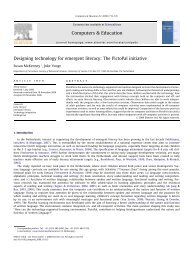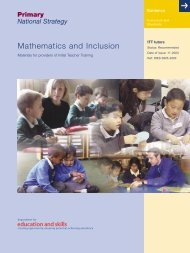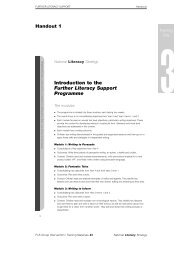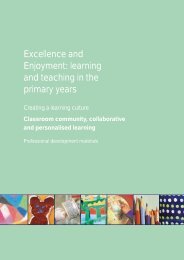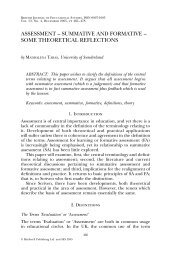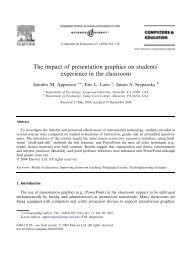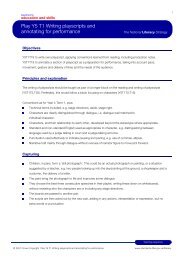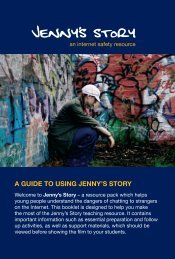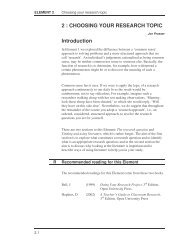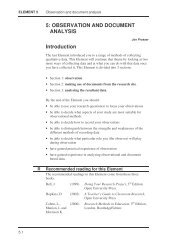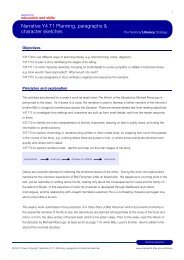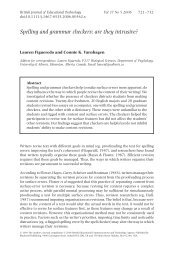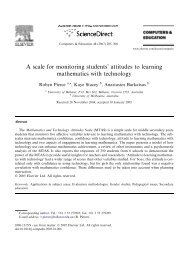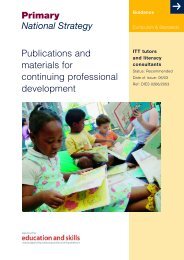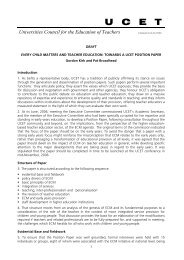Getting Started with Second Life - Jisc
Getting Started with Second Life - Jisc
Getting Started with Second Life - Jisc
Create successful ePaper yourself
Turn your PDF publications into a flip-book with our unique Google optimized e-Paper software.
<strong>Getting</strong> <strong>Started</strong> <strong>with</strong> <strong>Second</strong> <strong>Life</strong><br />
Maggi Savin-Baden, Cathy Tombs,<br />
Coventry University<br />
Dave White,<br />
University of Oxford<br />
Terry Poulton, Sheetal Kavia<br />
& Luke Woodham,<br />
St George’s University of London
<strong>Getting</strong> <strong>Started</strong> <strong>with</strong> <strong>Second</strong> <strong>Life</strong><br />
<strong>Second</strong> <strong>Life</strong> is a free 3D multi-user virtual world developed by Linden<br />
Labs in 2003, and is inhabited by millions of residents across the world.<br />
It is used as a platform for education by many institutions, such as<br />
colleges, universities, libraries and government entities, <strong>with</strong> over one<br />
hundred regions used for educational purposes. This ‘<strong>Getting</strong> <strong>Started</strong><br />
<strong>with</strong> <strong>Second</strong> <strong>Life</strong>’ guide is aimed at those who are wanting to use <strong>Second</strong><br />
<strong>Life</strong> for teaching in further and higher education. It provides in-depth<br />
descriptions of all aspects of the immersive world for both direct use<br />
and facilitating others’ use.<br />
Welcome to the <strong>Getting</strong> <strong>Started</strong> in <strong>Second</strong> <strong>Life</strong> guide! The guide has been<br />
written by representatives from several projects from <strong>with</strong>in JISC’s recent<br />
Users and Innovation programme, which gave project teams the opportunity to<br />
work in emergent technology spaces that at the time were the domain of very<br />
few in higher education. These included multi user virtual environments such<br />
as <strong>Second</strong> <strong>Life</strong>.<br />
Through a structured community and careful brokering of connections both<br />
in the UK and internationally, a group of projects came together that looked<br />
at these then only potential learning spaces and tried to make sense of them<br />
for an already busy higher education market. Their results and outputs far<br />
exceeded those laid down in their project plans, and are a testament to not<br />
only the projects’ own hard work, but the help and input of a wide range<br />
of other U&I projects whose staff volunteered their time to user test and<br />
participate ‘in world’ <strong>with</strong> events and exercises.<br />
Through the life of the <strong>Second</strong> <strong>Life</strong> projects information was gathered and<br />
analysed and, perhaps unsurprisingly, one area stood out as needing support<br />
more than any other - getting started. This then gave weight to the argument<br />
for a JISC Introductory guide to <strong>Second</strong> <strong>Life</strong>. And here it is: aimed at staff<br />
who are looking to connect through a virtual world to learning and research<br />
activities, this guide should be the first step in any proposed use of <strong>Second</strong> <strong>Life</strong><br />
for learning and teaching, providing a step by step approach and a range of<br />
guidance in the key areas and issues.<br />
Lawrie Phipps<br />
Programme Manager,<br />
Users and Innovation Programme<br />
JISC<br />
2
<strong>Getting</strong> <strong>Started</strong> <strong>with</strong> <strong>Second</strong> <strong>Life</strong><br />
Contents<br />
Introduction ...........................................................................................................................................4<br />
<strong>Getting</strong> started .......................................................................................................................................5<br />
Signing up and creating an avatar<br />
Stepping into <strong>Second</strong> <strong>Life</strong><br />
After logging on<br />
Orientation<br />
Creating a presence in-world<br />
Movement<br />
Communication: three ways<br />
Teleporting<br />
Next steps...............................................................................................................................................9<br />
Interacting <strong>with</strong> objects<br />
Maps<br />
Playing media<br />
Inventory<br />
Personal profile<br />
Beyond the basics.................................................................................................................................12<br />
Building and scripting<br />
Building<br />
Scripting<br />
Designing courses in <strong>Second</strong> <strong>Life</strong>.........................................................................................................15<br />
Background theory of facilitating learning<br />
Facilitating learning in <strong>Second</strong> <strong>Life</strong> ....................................................................................................18<br />
<strong>Getting</strong> started as a facilitator<br />
Common mistakes and assumptions ...................................................................................................20<br />
Common mistakes<br />
Misguided assumptions<br />
Practical concerns for your institution.................................................................................................23<br />
Automatic updates<br />
Computing power<br />
The ‘game’ problem<br />
Batch naming and registration<br />
Ethical issues<br />
Buying islands<br />
Permissions<br />
OpenSim<br />
Gaining support from senior management<br />
Supporting staff<br />
Using external support<br />
Useful links and books..........................................................................................................................26<br />
Glossary................................................................................................................................................27<br />
Abbreviations........................................................................................................................................29<br />
References............................................................................................................................................30<br />
3
<strong>Getting</strong> <strong>Started</strong> <strong>with</strong> <strong>Second</strong> <strong>Life</strong><br />
Introduction<br />
The first thing that everyone notices about <strong>Second</strong> <strong>Life</strong> is that it is a 3D graphical world which appears to<br />
be populated <strong>with</strong> pseudo-realistic humans <strong>with</strong> perfect bodies and elaborate hairstyles. This is quite an<br />
accurate description of the ‘virtual world’ which started to become popular in 2006. However, the graphical<br />
nature of <strong>Second</strong> <strong>Life</strong> can distract from the fact that it is not a single technology, but a range of online tools<br />
which cluster around a visual centre such as communications tools, 3D design tools to create or modify,<br />
and a scripting/programming language. <strong>Second</strong> life is also a ‘world’ <strong>with</strong> its own financial system complete<br />
<strong>with</strong> a currency and the ability to trade goods and services. It has a navigation/map system for travelling<br />
around and a ‘search’ system for finding people and places, like shops. It also allows you to choose how<br />
you look and what you wear, so that you possess both an inventory that contains everything that your avatar<br />
‘owns’ and an expandable set of ‘gestures’ that allow individuals to animate their avatar’s movements or<br />
expressions.<br />
This guide offers a basic overview of how to get started along <strong>with</strong> some tips on how to facilitate learning in this<br />
space. One of the difficulties <strong>with</strong> <strong>Second</strong> <strong>Life</strong> is that there is too much to learn by going through every menu or<br />
button systematically. It is better to pick up a few basics as outlined in this guide and experiment, rather than to<br />
get lost in the pursuit of mastering the detail of the environment. As you explore you may experience some of the<br />
following:<br />
■■<br />
■■<br />
■■<br />
■■<br />
It feels very lonely not being around other avatars and although some of the environments are<br />
visually appealing, you start to feel that the point of being in <strong>Second</strong> <strong>Life</strong> is maybe to communicate<br />
<strong>with</strong> others<br />
It’s easy to get lost ‘teleporting’ around from island to island. You get a sense that there are some<br />
really interesting locations in <strong>Second</strong> <strong>Life</strong> but that you just can’t find them. Most of them seem to be<br />
either deserted or a disco<br />
You have trouble flying and sitting down<br />
People tend to notice you are new to <strong>Second</strong> <strong>Life</strong> because of:<br />
o Your clothes<br />
o The way you move<br />
o The language you use<br />
You notice that your avatar’s appearance is like a huge badge that says ‘I don’t know what I’m doing’; you<br />
become slightly envious of those around you <strong>with</strong> a more individual appearance and begin to wonder how<br />
they acquired their impressive hair and clothes. This leads to an extended period of playing <strong>with</strong> your<br />
avatar’s ‘appearance’ settings, which ends <strong>with</strong> it looking slightly less ‘default’ but still fairly unpleasing.<br />
■■<br />
■■<br />
■■<br />
You get the suspicion that everyone else is role playing and that they can’t be fully trusted. You feel<br />
that everyone else is simply using the environment to play out fantasies and that their avatars are<br />
unlikely to be an accurate reflection of their real life bodies or personas. This seems intriguing but<br />
ultimately false. At this point you have forgotten that you made your avatar a 7’2’’ fireman<br />
You hope nobody starts talking to you<br />
You try to build something but find you can only produce boxes and you just keep getting stuck<br />
First impressions vary but the point that’s being made here is that <strong>Second</strong> <strong>Life</strong> encourages individuals to<br />
think and act socially. Most people get a powerful sense of being present <strong>with</strong> other people in <strong>Second</strong> <strong>Life</strong><br />
and while the graphics are in no way ‘realistic’, their level of detail appears to be enough to trigger social<br />
4
<strong>Getting</strong> <strong>Started</strong> <strong>with</strong> <strong>Second</strong> <strong>Life</strong><br />
and interpersonal responses. These types of environments have been described not as ‘virtual reality’ but<br />
as ‘good enough’ reality, to the extent that individuals carry many real life social codes into <strong>Second</strong> <strong>Life</strong>. For<br />
example, individuals tend not to place their avatar too close to another as they feel that avatars have a form<br />
of personal space. There has also been criticism (particularly by people in the gaming field) that the graphics<br />
are poor and laboured. However, we believe that as <strong>Second</strong> <strong>Life</strong> is being used for educational purposes this<br />
is not of great concern.<br />
<strong>Getting</strong> started<br />
This section gives a basic overview of the things you need to know to begin using <strong>Second</strong> <strong>Life</strong>. It is a stage<br />
which is found to be challenging, disarming and problematic by both staff and students. It is helpful to<br />
bear in mind that <strong>Second</strong> <strong>Life</strong> is more than a piece of software; it is also home to a loose form of culture<br />
<strong>with</strong> its own codes of conduct and forms of communication. The environment has attracted those looking<br />
to experiment <strong>with</strong> identity, building, sex, fashion, business, art and science. The practice of learning and<br />
teaching is just one of the many aspects of real life which is finding its way in <strong>Second</strong> <strong>Life</strong> alongside an<br />
intrepid population of early adopters.<br />
Signing up and creating an avatar<br />
With <strong>Second</strong> <strong>Life</strong> you have a choice of two types of accounts when signing up: the first is a free membership<br />
and the second a premium membership which is charged on a monthly basis and entitles you to become a<br />
land owner. Most universities that have land in <strong>Second</strong> <strong>Life</strong> have a premium membership and therefore as<br />
an individual you will just need to sign up as a free member.<br />
Naming yourself<br />
With every virtual world you need to sign up to create your virtual presence known as your avatar. When<br />
signing up to <strong>Second</strong> <strong>Life</strong> you must create a name for your avatar. The first name is any name you wish, but<br />
your second name must be selected from a given list.<br />
Creating yourself<br />
At the same time you must select an appearance for your avatar, and this is important as your appearance<br />
can say a lot about you in <strong>Second</strong> <strong>Life</strong>. It is important to note that you are able to change your appearance<br />
countless times by using the appearance editor and by using the numerous readily available shapes and<br />
outfits in your inventory.<br />
Stepping into <strong>Second</strong> <strong>Life</strong><br />
After creating an account you need to download the <strong>Second</strong> <strong>Life</strong> application and ensure that your system has<br />
the minimum requirements to run it. (Information on this can be found at http://secondlife.com/corporate/<br />
sysreqs.php.)<br />
After logging on<br />
At the top of the screen there is a classic drop-down menu bar from which you can control the <strong>Second</strong><br />
<strong>Life</strong> settings. One of the important options is in edit preference and world environment settings. Along the<br />
bottom of the screen there are shortcuts to some of the options such as chat (the first button on the bottom<br />
5
<strong>Getting</strong> <strong>Started</strong> <strong>with</strong> <strong>Second</strong> <strong>Life</strong><br />
left), flying, search, maps and most importantly your inventory. Above your inventory button, you will notice a<br />
few more buttons and these are for voice chat, playing media and audio and volume control for all.<br />
Orientation<br />
The first place you will arrive is Orientation Island, in common <strong>with</strong> everyone else new to <strong>Second</strong> <strong>Life</strong> (this<br />
can be hard work and time consuming). Some universities have their own spaces to which direct teleporting<br />
is possible. The means of doing this is discussed in the ‘Practical concerns for your institution’ section.<br />
On Orientation Island you will be prompted to begin a tutorial which will teach you some of the basics<br />
capabilities you will need. To enter the mainland of <strong>Second</strong> <strong>Life</strong> you must find the exit in the Orientation Help<br />
Island. Things to note:<br />
■■<br />
■■<br />
■■<br />
■■<br />
■■<br />
Collect note cards from the Orientation Island which will remind you of functions learnt there,<br />
because once on the mainland you will be unable to return to the Orientation Island. There is<br />
however a replica of the Orientation and Help Island on the mainland which can easily be accessed<br />
Browse your preferences options in the edit menu so that you can make the most out of your<br />
experience in <strong>Second</strong> <strong>Life</strong>. There are settings which control the way you see the world, and controls<br />
for functions such as media and audio<br />
Try to take time each week to become familiar <strong>with</strong> <strong>Second</strong> <strong>Life</strong>, as this will increase your<br />
confidence in the programme and will be particularly important when trying to facilitate in-world<br />
activities<br />
Learn to use your voice controls on the microphone and speakers/headphones<br />
Search buttons are very useful for finding different places, islands, events and people on <strong>Second</strong><br />
<strong>Life</strong>. The main map is always useful for finding your way around <strong>Second</strong> <strong>Life</strong> and the mini map is<br />
useful for finding your way around your current location<br />
Figure 1. The <strong>Second</strong> <strong>Life</strong> interface<br />
6
<strong>Getting</strong> <strong>Started</strong> <strong>with</strong> <strong>Second</strong> <strong>Life</strong><br />
Creating a presence in-world<br />
Once you have had enough time to get to know the <strong>Second</strong> <strong>Life</strong> interface and applications, creating your own<br />
presence in-world is a good idea. In practice this means moving away from being a ‘newbie’ (a new in-world<br />
person). Most ‘newbies’ are easily recognisable from their standard set appearance and most advanced users<br />
are seen to have more adventurous costumes. The way you look in-world says a lot about you. To create a<br />
presence you play <strong>with</strong> your appearance settings and editor, which will not only impress the students you are<br />
facilitating, but also enable them to see that you look different from them, and identify you. Sometimes it is<br />
easier to spot the facilitator when in large groups if the facilitator is somewhat different from the rest.<br />
Movement<br />
To move your avatar in <strong>Second</strong> <strong>Life</strong>, use the up arrow key to walk forwards and the down arrow key to walk<br />
backwards. The left and right keys rotate your avatar on the spot. Press ‘Page Up’ to make your avatar<br />
airborne, and ‘Page Down’ to lower it back to the ground. The arrow keys move your avatar in the relevant<br />
direction whilst flying. You can also use your mouse by clicking on buttons on the movement menu.<br />
Figure 2. The movement controls<br />
Communication: three ways<br />
1) Local Chat<br />
Avatars <strong>with</strong>in a ten-metre range of each other can communicate via the Local Chat text box. Type content into<br />
this box and press ‘Say’ to speak to other avatars. You can also choose the option ‘Shout’, which has a louder<br />
range if you want avatars further away to hear you. To view a history of all chat, click the ‘local chat’ button.<br />
2) Instant Message<br />
The second way of communicating in <strong>Second</strong> <strong>Life</strong> is via private Instant Message. Click the ‘Communicate’<br />
button at the bottom of the screen; choose the ‘Contacts’ tab and then select whichever avatar you wish to<br />
talk to from the list of ‘Friends’ or, if you wish to communicate to a number of people, ‘Groups’. Clicking the<br />
IM/Call button on the right brings up a window in which you can chat privately to another avatar.<br />
7
<strong>Getting</strong> <strong>Started</strong> <strong>with</strong> <strong>Second</strong> <strong>Life</strong><br />
3) Voice Chat<br />
The third method of communication is via voice chat. If a person has a microphone and speakers/headphones,<br />
their voice will be projected into <strong>Second</strong> <strong>Life</strong> so that those who have voice chat enabled will be able to hear<br />
them and can respond accordingly, either by text or voice as well. To enable voice chat, go to Edit > Preferences<br />
> Voice Chat and tick the box. A button at the bottom right of your screen will then appear labelled ‘Talk’. By<br />
holding down this button, other users in <strong>Second</strong> <strong>Life</strong> will be able to hear your voice, provided your microphone<br />
is plugged in. Like Instant Messaging, you can also have a private voice conversation <strong>with</strong> a contact.<br />
Figure 3. The communication interface<br />
Teleporting<br />
Teleporting in <strong>Second</strong> <strong>Life</strong> is a convenient and quick way to get from one place to another, whether it be in<br />
the same region or an entirely different region altogether. To use a teleport, right click and select ‘Teleport’<br />
from the menu. Some objects are scripted so that a simple left click can also teleport the avatar.<br />
Figure 4. Preparing to teleport<br />
8
<strong>Getting</strong> <strong>Started</strong> <strong>with</strong> <strong>Second</strong> <strong>Life</strong><br />
You can also be offered a teleport from another avatar to their location, which will appear in a popup on<br />
the top right corner of your screen. Similarly, you can teleport a contact to your own location by visiting the<br />
‘Communicate’ menu or their profile.<br />
Next steps<br />
This next section gives advice about how to go beyond just moving, getting dressed and communicating in<br />
<strong>Second</strong> <strong>Life</strong>, and will help you to explore the medium more fully.<br />
Interacting <strong>with</strong> objects<br />
There are many objects <strong>with</strong>in <strong>Second</strong> <strong>Life</strong> that are scripted to allow interaction between the object and the<br />
avatar; for example, touching a door will open it. These objects can be interacted <strong>with</strong> by right clicking and<br />
selecting ‘Touch’ from the menu, or simply by left clicking.<br />
To sit on an object, right click and select ‘Sit Here’ from the menu. Occasionally chairs and sofas have ‘pose<br />
balls’ visible and left clicking on these will seat your avatar.<br />
Figure 5. Preparing to sit down<br />
To return your avatar to a standing position, click the ‘Stand Up’ button at the bottom of the screen or right<br />
click the object and select ‘Stand Up’ from the menu.<br />
Objects occasionally also give note cards or landmarks when you touch them. Note cards are an extremely useful<br />
way of receiving information in <strong>Second</strong> <strong>Life</strong>. When touching an object that offers a note card, you can touch either<br />
‘Keep’ or ‘Discard’. Choosing the option ‘Keep’ opens up the note card for viewing. However, be careful what you<br />
accept, as some note cards can result in spam mail, particularly those relating to gambling areas of <strong>Second</strong> <strong>Life</strong>.<br />
Camera angles<br />
To change your view on screen, you can change the camera angle. Use the scroll wheel on the mouse to<br />
zoom in and out. If you zoom in to the maximum level then you will enter ‘mouselook’ mode which allows you<br />
to look around using the mouse from the avatar’s perspective. Another option is to go to View > Mouselook at the<br />
top of the screen. To exit mouselook mode simply zoom out again using the scroll wheel, or press the Esc button.<br />
9
<strong>Getting</strong> <strong>Started</strong> <strong>with</strong> <strong>Second</strong> <strong>Life</strong><br />
If you press and hold Ctrl + Alt and hold down the left mouse button whilst moving the mouse around, you<br />
can point the camera in all directions, giving a much better viewing experience. You can also use the camera<br />
movement tool by clicking on the buttons to move the camera around.<br />
Figure 6. The camera controls<br />
Maps<br />
A useful tool in <strong>Second</strong> <strong>Life</strong> is called the ‘Mini Map’, located in the top right corner of your screen. The mini<br />
map shows the entirety of the island where your avatar is located, as shown below in Figure 7. The grey<br />
represents objects, the blue represents objects your avatar owns and the purple are group-owned objects.<br />
The yellow dot is your avatar, and any green dots scattered around represent other avatars on the island.<br />
Figure 8. Media buttons<br />
Figure 7. The Mini Map<br />
You can also open up the ‘World Map’ from View > World Map, which can show all the other regions around<br />
the one where you are located, as well as land for sale, events, info hubs and more. You can use the World<br />
Map to find a different region by typing a location or name into the search box.<br />
Playing media<br />
Media is an integral part of <strong>Second</strong> <strong>Life</strong> <strong>with</strong> constant sound effects and music. The buttons at the bottom<br />
right of the screen are used to start and stop the media and adjust volume. Videos are also streamed into<br />
<strong>Second</strong> <strong>Life</strong>, onto screens dotted around certain locations.<br />
10
<strong>Getting</strong> <strong>Started</strong> <strong>with</strong> <strong>Second</strong> <strong>Life</strong><br />
As you can see from the icons in Figure 8, a video is currently being played but the greyed out music icon<br />
means there is no additional sound available.<br />
Inventory<br />
Any objects your avatar might make or pick up, as well as note cards, landmarks, bought objects and textures,<br />
are placed in your avatar’s ‘inventory’. When first joining <strong>Second</strong> <strong>Life</strong>, the inventory comes <strong>with</strong> pre-made<br />
objects, textures, landmarks and more, but you can continuously add to it, by either buying new items or<br />
creating your own. Landmarks and note cards are always free and go automatically into the relevant folders.<br />
Figure 9. Example of an inventory<br />
You can search the inventory for objects you might need by typing the name or part of the name of the object<br />
into the text box at the top, or searching for your most recent items.<br />
Personal profile<br />
When in the same region as other avatars, you can view their profile by right clicking and selecting Profile. Likewise,<br />
you can click on your own avatar to edit your profile. Profiles are a good way to let other avatars know what you are<br />
interested in, where you might frequent and what you do in your spare time. The amount of information you put in is<br />
entirely up to you, but it would be wise not to be too personal, as anyone can view your profile.<br />
Figure 10. Avatar profile<br />
11
<strong>Getting</strong> <strong>Started</strong> <strong>with</strong> <strong>Second</strong> <strong>Life</strong><br />
Beyond the basics<br />
This section is for those who want to do more than use the space for learning and teaching, for example,<br />
using problem-based learning or small group teaching. It will guide you through the process of basic<br />
building and help you to understand what scripting involves and how to do it.<br />
Building and scripting<br />
A significant factor in the appeal of <strong>Second</strong> <strong>Life</strong> for many universities is the ability to build in the<br />
environment. Across <strong>Second</strong> <strong>Life</strong> nearly all the content in the environment is designed and built by those<br />
using it, including buildings, vehicles and avatar attachments such as clothes, jewellery and certain<br />
hairstyles. Once an object has been built, interactivity and behaviour can be added to it using scripting.<br />
There are a great many resources available on the web that provide tutorials and guidance for content<br />
creation in <strong>Second</strong> <strong>Life</strong>. Two of the most comprehensive, which represent good places to start, are the<br />
<strong>Second</strong> <strong>Life</strong> Support Centre (http://support.secondlife.com), which offers an extensive knowledge base of<br />
common questions and solutions, and the <strong>Second</strong> <strong>Life</strong> wiki (http://wiki.secondlife.com) which offers tutorials<br />
for building and scripting, templates for object and code design, and a complete reference to the <strong>Second</strong> <strong>Life</strong><br />
scripting commands and syntax.<br />
Building<br />
<strong>Second</strong> <strong>Life</strong> provides tools for building and modifying objects as part of the standard <strong>Second</strong> <strong>Life</strong> viewer, so<br />
no additional software is required. These tools are relatively simple and do not contain the advanced options<br />
provided by dedicated 3D modelling suites such as 3D Studio Max and Blender. This approach ensures that<br />
it is relatively simple to build basic objects, although a certain amount of ingenuity and creative thought is<br />
required to model more complex shapes using the basic tools available.<br />
In order to build it is necessary to have access to land on which building (or ‘rezzing’) is permitted by the<br />
landowner. This may be land that is personally owned or land that is designated as a public ‘sandbox’. A<br />
sandbox is an area that has been made available for building and testing objects, and many are made publicly<br />
available to allow residents that do not own land to develop their building skills. A number are provided by<br />
Linden Labs, and can be found by typing ‘sandbox’ into the region search field on the map screen.<br />
Objects in <strong>Second</strong> <strong>Life</strong> are constructed out of constituent parts known as primitives, or ‘prims’. There are 15<br />
basic prim shapes (Cube, Prism, Pyramid, Tetrahedron, Cylinder, Hemicylinder, Cone, Hemicone, Sphere,<br />
Hemisphere, Torus, Tube, Ring, Tree, Grass) which can be rezzed from the <strong>Second</strong> <strong>Life</strong> building interface.<br />
Having rezzed an instance of a prim, numerous modifiers can be applied to alter its size, form, position and<br />
orientation. Objects can be moved using the axes displayed around the object when it is selected for editing.<br />
Holding the Ctrl key changes these move handle axes into rotate handles, and holding Ctrl and Shift brings<br />
up stretch handles. With these handles displayed the mouse can be used to manipulate the object. Further<br />
transformations such as twists, shears and hollowing can be applied by modifying the parameters under the<br />
Object tab on the building dialog box.<br />
12
<strong>Getting</strong> <strong>Started</strong> <strong>with</strong> <strong>Second</strong> <strong>Life</strong><br />
Figure 11. A prism prim displaying move axes<br />
When first rezzed, all prims are displayed <strong>with</strong> a default wood grain texture. This texture can be changed,<br />
along <strong>with</strong> the colour of the object. New textures can be obtained from many in-world sources, and a library<br />
of default textures is accessible to all avatars. External image files can also be imported for a small fee of<br />
10L$ (Linden Dollars), enabling photographs and other images to be displayed in-world. Multiple textures<br />
can be applied to different faces of an object, and the orientation and repetition of these textures modified<br />
to achieve the desired effect. The appearance of textured objects can be modified further by adjusting<br />
parameter values that determine their transparency, shininess and luminosity/glow.<br />
Combining multiple prims allows more complex objects to be created. The constituent prims can simply<br />
be positioned relative to each other to give the visual impression of being a single object. In cases where<br />
the object is intended to be inanimate or for scenery such as road sections, this is perfectly acceptable.<br />
However, when an object consisting of multiple prims is required to be moved or scripted in some way it is<br />
usually necessary to link the objects together so that actions and movements act upon the object as a whole.<br />
Moving a linked object will cause its position in the environment to change, but the position and orientation<br />
of the constituent prims relative to each other will remain unaltered. A linked object takes a single ‘root’<br />
prim as its reference point for determining its position, and this root prim also acts as the content holder<br />
for any scripts or objects to be included <strong>with</strong>in the object. The identity of the root prim is determined by its<br />
having been the last object to be selected before the command to link the objects was given. When an object<br />
consisting of linked prims is selected the root prim will be highlighted in yellow, while all other prims are<br />
highlighted in blue.<br />
Objects also have a number of properties which can be altered. These settings can have a bearing on how<br />
the object responds to events and actions in the surrounding environment, and include properties such as an<br />
object being temporary (causing it to be deleted after having been rezzed for a short period), flexible (causing<br />
it to move or bend according to wind conditions and gravity) or phantom (allowing avatars or other objects<br />
to pass through it <strong>with</strong>out a collision occurring). Objects can also be made physical, which imposes a more<br />
sophisticated and realistic set of physical constraints upon the object, ie the object is subject to gravity and<br />
other forces which are not applied to non-physical objects.<br />
13
<strong>Getting</strong> <strong>Started</strong> <strong>with</strong> <strong>Second</strong> <strong>Life</strong><br />
Figure 12. A paramedic suction unit constructed by linking 44 prims<br />
Scripting<br />
As a complement to its building tools, <strong>Second</strong> <strong>Life</strong> provides a scripting language which allows residents<br />
to add behaviours and interactivity to the objects that they create. Linden Scripting Language (LSL) is a<br />
language specifically designed for <strong>Second</strong> <strong>Life</strong>. It follows many of the conventions associated <strong>with</strong> fullfeatured<br />
programming languages, and is structurally similar to Java and C. There are numerous LSL<br />
examples and tutorials available both on the web and in-world. The LSL Portal (http://wiki.secondlife.com/<br />
wiki/LSL_Portal) on the <strong>Second</strong> <strong>Life</strong> Wiki provides a comprehensive reference to the LSL language.<br />
For a script to be active and able to run it must be contained in an object that is rezzed in-world. Scripts<br />
contained in inventory, whether inside an object or on their own, cannot be run. A script, when activated, will<br />
influence the behaviour of its container object. It may cause the object to move in position and/or orientation,<br />
change form, display text, change appearance or send messages. A script can also determine how the object<br />
responds to external stimuli, such as being touched by avatars, colliding <strong>with</strong> other objects, or hearing<br />
messages. Particle effects such as snow, smoke or steam can be generated by using scripts to rez many<br />
instances of very small objects. Similarly, larger-scale objects can be generated by scripts where required.<br />
Scripts are written using the editor built into the standard <strong>Second</strong> <strong>Life</strong> viewer. This editor is brought up by double<br />
clicking a new or existing script, and acts much like a conventional text editor, allowing code entry and editing.<br />
Figure 13. The default script, shown in the script editor on the right<br />
14
<strong>Getting</strong> <strong>Started</strong> <strong>with</strong> <strong>Second</strong> <strong>Life</strong><br />
As <strong>with</strong> all languages, there are conventions of style that should be followed when creating scripts. These<br />
conventions help to ensure that code can be easily understood by developers who need to use or adapt other<br />
developers’ content. A document detailing the key guidelines for coding style can be found at http://wiki.<br />
secondlife.com/wiki/LSL_Style_Guide, and includes guidance on code layout, variable naming conventions<br />
and code separation.<br />
Before a script can be run it must be saved and compiled. The compilation process generates an optimised,<br />
non-human readable version of the script, but this process can only be completed if the script is free from<br />
errors. Attempting to save a script containing errors will result in the compilation process failing and a<br />
description of the first error encountered and the line number on which it occurs being output to the editing<br />
tool. Repeatedly attempting to save a script and tackling each error in turn is often necessary before a script<br />
will pass the validation checks and save successfully. However, in some cases the line numbers that are<br />
indicated by the tool can be misleading when it comes to identifying the location of an error and the steps<br />
needed to resolve it. For instance, an error may be detected by the tool upon reaching a certain line, but this<br />
may be caused by the omission of a closing bracket or semi-colon on a line further up in the script.<br />
Figure 14. Example of a syntax error when compiling a script.<br />
Note that the tool suggests that the error is on line 5, when in fact it is caused by a missing semi-colon on line 4<br />
Designing courses in <strong>Second</strong> <strong>Life</strong><br />
Whilst theories of learning have never been static, the distinction between and across the approaches –<br />
behavioural, cognitive, developmental and critical pedagogy – continues to be eroded. There is increasing<br />
focus in the 21st century on what and how students learn, and on ways of creating learning environments<br />
to ensure that they learn effectively – although much of this remains contested ground. New models and<br />
theories of learning have emerged over the last decade which inform the development of learning in <strong>Second</strong><br />
<strong>Life</strong>. For example, the work of Trigwell et al. (1999) on teachers’ conceptions of learning offers useful<br />
insights into the impact such conceptions have on student learning. Yet, the work of Meyer and Land (2006),<br />
Haggis (2004), and Meyer and Eley (2006) have been critical of studies into conceptions of teaching and<br />
approaches to learning. Thus <strong>with</strong> the shift into Web 2.0 technologies, and the increasing focus on learning<br />
and interaction through social networking, it may be advisable to develop academic regulations that fit<br />
15
<strong>Getting</strong> <strong>Started</strong> <strong>with</strong> <strong>Second</strong> <strong>Life</strong><br />
more effectively <strong>with</strong> these approaches to learning than the objectives model of education. For example, a<br />
learning outcomes model of education has a behavioural focus in terms of what the students must do and<br />
what content they must cover, what is measurable and recordable. This model is teacher-centred. Perhaps<br />
it would be increasingly appropriate to adopt a more flexible approach when designing courses for <strong>Second</strong><br />
<strong>Life</strong>, that reflects the principles and practices of social networking. An example would be the intentional<br />
model of course design, which focuses on a notion of responsible learning embracing the idea that learning,<br />
rather than teaching, is central to higher education. It is a student-centred approach, so it is the ‘intentions’<br />
of the teacher that are described, what the teacher ‘expects’. The focus then is on multiple models of action,<br />
knowledge, reasoning and reflection, along <strong>with</strong> opportunities for the student to challenge, evaluate and<br />
interrogate them. Thus in this model effective teaching is designed to change society in substantive ways.<br />
The idea then would be to utilise the notion of learning intentions rather than objectives for Web 2.0<br />
curricula. Theoretically this is based on both Stenhouse (1975) and Pratt et al. (1998) combining Stenhouse’s<br />
notion of ‘induction’ and Pratt’s notion of Social Reform. This would provide a different course design<br />
rhetoric which is more resonant <strong>with</strong> many of the practices we actually use already and allow for the<br />
possibility of ‘regulating for flexibility’. Thus, the curriculum becomes based upon the idea that knowledge<br />
is contested and speculative, and thus although content is specified there is not necessarily disciplinary<br />
structure. This learning intentions model focuses on equivalence of experience, since in any system of<br />
higher education it is not ultimately possible to ensure equity. The focus is on quality learning, whilst<br />
acknowledging that quality is not unproblematic.<br />
Issues of facilitation or course design?<br />
Early work on exploration of the role of different staff was carried out by Peters (1998), who identified five<br />
types of course design teams for distance learning, which are summarised below:<br />
Type 1: A university lecturer who is solely responsible for developing and running an online course. They<br />
may have had some experience of online learning but may not have worked as part of a team or know the<br />
literature on online education.<br />
Type 2: A university lecturer who co-authors <strong>with</strong> educational technologists.<br />
Type 3: A learning technologist or a group of learning technologists who are responsible for developing a course.<br />
Type 4: University lecturers, learning technologists, graphic designers, editors and media specialists who<br />
work together as a course team and develop a course for which they are jointly responsible.<br />
Type 5: An expert online teacher and experienced faculty member who is aware of the educational and technical<br />
issues of online learning, and uses the support of a learning technologist for preparation of course materials.<br />
These are the delineations of the types that are often seen in the design of immersive virtual worlds<br />
programmes. What tends to happen most often is that the education drive for developing immersive virtual<br />
worlds comes from the Type 1 facilitators, who then seek support from one another and maybe also a<br />
learning technologist. The module or course is thus pedagogically driven but the materials are not always<br />
well designed in terms of learning technology. This then introduces issues as to what counts not just as good<br />
design but also as good facilitation.<br />
Background theory of facilitating learning<br />
In earlier texts the notion of facilitation at different levels has been discussed and in particular what might<br />
count as effective facilitation. Salmon has provided a comprehensive guide to ‘e-moderating.’ An electronic<br />
16
<strong>Getting</strong> <strong>Started</strong> <strong>with</strong> <strong>Second</strong> <strong>Life</strong><br />
moderator is someone who ‘presides over an electronic online meeting or conference’ (Salmon 2000:3).<br />
She draws on research from staff and students’ perspectives, offers guidance on training e-moderators and<br />
suggests a useful model for teaching through computer-mediated communication.<br />
Carlson’s definition of a moderator online is one who:<br />
“Helps people get started, gives them feedback, summarizes, weaves the contributions of different folks<br />
together, gets it unstuck when necessary, deals <strong>with</strong> individuals who are disruptive, or get off the track,<br />
brings in new material to freshen it up periodically, and gets feedback from the group on how things are<br />
going and what might happen next...[Further the moderator needs to] communicate <strong>with</strong> the group as a<br />
whole, sub-groups, and individuals to encourage participation.”<br />
(Carlson, 1989: 6.11)<br />
However, there has been little documented in the literature about the role of the facilitator in immersive<br />
virtual worlds. For some, there is an assumption that when eight students share a computer to engage<br />
<strong>with</strong> a scenario it is sufficient for a roving tutor to call round briefly to each team. Yet this does not mirror<br />
the current notions of immersive virtual worlds facilitation, and in many ways downgrades the role of the<br />
facilitator in an immersive virtual worlds team. A virtual model of facilitation that reflects some of the best<br />
face-to-face problem-based learning facilitation practices is required. So a facilitator could join in the email<br />
debates students are having and call in on discussions. Yet there are problems too <strong>with</strong> this in terms of<br />
staff time and students’ participation. For example, how do we deal <strong>with</strong> students who do not participate in<br />
immersive virtual worlds? How do we deal <strong>with</strong> colleagues who are too directive and interfere <strong>with</strong> the team<br />
process and progress?<br />
In recent years there have been increasing debates about whether facilitation is just a form of good<br />
teaching or whether in fact it is something else (for example, Boud and Miller, 1996). Heron (1989; 1993) has<br />
suggested three modes of facilitation that may be useful for helping us understand how facilitators consider<br />
enabling learning in immersive worlds. They are as follows:<br />
The hierarchical mode: Here the facilitators direct the learning process and exercise their power over it. Thus<br />
they decide (however covertly) the objectives of the team, challenge resistances, manage team feeling and provide<br />
structures for learning. In short, the facilitators take responsibility for the learning that takes place.<br />
The co-operative mode: The facilitators share their power over the learning <strong>with</strong> the team and enable the<br />
team to become more self-directed by conferring <strong>with</strong> them. The facilitators prompt the team members to<br />
decide how they are going to learn and to manage confrontation. Although the facilitators share their own<br />
views, these are not seen as final but as views amongst many.<br />
The autonomous mode: The facilitators respect the total autonomy of the team; the facilitators do not<br />
do things for or <strong>with</strong> the team, but give them the space and freedom to do things their own way. Without<br />
guidance, reminders or assistance, the team evolves its learning and structure, finds its own ways to<br />
manage conflict and gives meaning to personal and team learning. The facilitator’s role is that of creating<br />
conditions in which students can exercise self-determination in their learning.<br />
The modes are not designed to be discrete or hierarchical and do to some extent overlap <strong>with</strong> one another.<br />
These are useful guides, particularly when coupled <strong>with</strong> the further descriptions that Heron has added, but<br />
there are also some rather obvious and helpful issues that need to be considered when learning to be a<br />
facilitator in immersive worlds.<br />
17
<strong>Getting</strong> <strong>Started</strong> <strong>with</strong> <strong>Second</strong> <strong>Life</strong><br />
Facilitating learning in <strong>Second</strong> <strong>Life</strong><br />
One of the central principles of facilitating immersive virtual worlds is that until we understand our own<br />
pedagogical stance (ie what we believe and stand for in learning and teaching) it is difficult to operate<br />
effectively as an immersive virtual worlds facilitator. Thus until we understand our own views about<br />
teaching and our ideas about collaboration in online spaces and are able to consider the issues of student<br />
responsibility, it is difficult to locate ourselves in these complex spaces. Therefore a useful starting point is<br />
to ask yourself about how you see your position as a facilitator in immersive virtual worlds:<br />
How much guidance do I expect to give to the students?<br />
How do I expect groups to work?<br />
What do I believe are the students’ roles?<br />
How do I see the relationship between immersive virtual worlds and the rest of the curriculum?<br />
What is the nature of the problem scenarios used in problem-based learning and assumptions implicit<br />
<strong>with</strong>in the construction of these scenarios?<br />
What do I see as the relationship between immersive virtual worlds and the assessment methods?<br />
How have I/will I create space that enables students to reflect upon individual and collective goals?<br />
Some things to consider at the outset include:<br />
■■<br />
■■<br />
■■<br />
Ensure you know the scenario you are facilitating and also the learning objectives/intentions you<br />
would expect students to address in the session<br />
Before you facilitate in-world, it is a good idea to try out the scenarios so you understand how they work<br />
Know the target audience (in this case the students) who are going to be taking part in the session,<br />
so that you understand the level of knowledge they will apply to the scenario<br />
<strong>Getting</strong> started as a facilitator<br />
Although it is possible to plan the programme well in advance and arrange for staff members to undertake<br />
an e-moderation programme, there are some principles of facilitating immersive virtual worlds that differ<br />
from other models of e-moderation, in which <strong>Second</strong> <strong>Life</strong> facilitators should:<br />
1) Guide but not interrupt. There is a tendency, particularly at the start of a session where students are<br />
presented <strong>with</strong> a new problem or activity, to interrupt or even pre-intervene by asking leading questions<br />
before the team have had a chance to discuss the problem. For example, if there is silence some staff will<br />
begin the scenario for the students by asking a question. It is better to wait, or to ask a gentle question such<br />
as ‘what are the team thinking about this?’<br />
2) Represent etiquette. Although much has been written on online etiquette (netiquette) there are differences<br />
in immersive virtual worlds, particular in relation to respecting silence, promoting student autonomy,<br />
and not interrupting when flaming occurs. This is largely because if facilitators interrupt or take control,<br />
the locus of control shifts to the member of staff and the team do not deal <strong>with</strong> the problem or conflict<br />
themselves. There is a delicate balance here, but it is important for staff to model this and also to help<br />
students develop ground rules for their own team.<br />
18
<strong>Getting</strong> <strong>Started</strong> <strong>with</strong> <strong>Second</strong> <strong>Life</strong><br />
3) Acknowledge and use prior experience. Many tutors feel that becoming a facilitator seems to be such a<br />
different role when they first begin that often they forget to draw on their prior experience. For example,<br />
one approach might be to reflect on the experience of being supervised in a research project. Often the<br />
supervisor guides the students in the early stages of the project, but towards the end the students may<br />
overtake their knowledge base. Another option might be to imagine the facilitator role as being that of a nondirective<br />
counsellor who uses reflection and questioning rather than direction.<br />
4) Recognise that being a facilitator means also being a learner. This might mean learning to develop the<br />
capabilities of a facilitator and learning new knowledge <strong>with</strong> and through the students. The process of<br />
becoming a facilitator also demands developing and understanding the way in which facilitator and team<br />
influence one another in the learning process.<br />
5) Ensure that the team’s concerns are heard. Active listening skills are a prerequisite to good<br />
communication and are one of the most effective tools for helping online teams manage conflict. There is<br />
often an assumption that ‘hearing’ what is occurring online is very difficult, but learning to read the subtext<br />
of discussion forums and chat sessions is a skill facilitators need to develop. Although this is complex to<br />
begin <strong>with</strong>, the ability to read team interactions in online spaces does develop over time.<br />
6) Listen and lurk positively. There is often a tendency, after using straightforward online learning, to retain<br />
control rather than granting it to the students. The notion of ‘lurking’ often seems to imply that silence and<br />
watching are inherently bad, but students often need to watch and listen in immersive virtual worlds, so it is<br />
important not to confuse lurking <strong>with</strong> thinking space.<br />
7) Provide supportive interventions. It is often easy to assume that not intervening means maintaining<br />
silence, but it is useful if students ‘know’ you are part of the discussion. Rather than just lurking it is helpful<br />
to students if the facilitators add some remark that illustrates they are listening and supporting the learning,<br />
but in a way that does not interrupt the students’ discussion. Although this is difficult, statements such as ‘I<br />
think this an interesting discussion’ or ‘would all the team agree <strong>with</strong> this?’ are useful general statements<br />
for supporting students.<br />
8) Promote personal reflection. Rather than weaving and summarising the discussion as a facilitator, it is<br />
possible to encourage the students to reflect and summarise their own discussion and stances at the end of a<br />
given time period or problem. This encourages not only group reflection but also the synthesis of the process of<br />
what has occurred, as well as the synthesis of the information that has been collected and collated.<br />
9) Encourage team criticality. One of the most difficult capabilities for students in immersive virtual worlds is<br />
in taking a critical stance. Many of those who have researched immersive virtual worlds report that there is a<br />
tendency for students to focus on the process of learning and the information collected, rather than taking a<br />
critical stance towards the way they are working and the knowledge produced (see for example Hmelo-Silver<br />
et al., 2006; Lycke et al., 2006). Ways of encouraging the development of criticality include suggesting the<br />
use of a team wiki, using blogs for assessment and asking students to summarise and critique each other’s<br />
contributions. The latter activity is very demanding of students and often difficult to do, but if the teams have<br />
been well supported and are cohesive this is often a possibility. One way of beginning this process is to use<br />
interesting activities <strong>with</strong>in the team which are competitive, such as treasure hunts, but where the team<br />
themselves have to decide which team member wins and say why this is.<br />
10) Use intuition. In the context of immersive virtual worlds little attention has been given to the role of<br />
intuition in facilitation. Arguments abound as to whether uploading handouts and detailed lecture notes onto<br />
WebCT/Blackboard is something that helps or hinders student learning. Yet both staff and students’ stories<br />
19
<strong>Getting</strong> <strong>Started</strong> <strong>with</strong> <strong>Second</strong> <strong>Life</strong><br />
of their experience of immersive virtual worlds would seem to suggest that intuition is very much part of the<br />
process of learning and facilitation. Facilitators often speak of knowing when the team is going well, and<br />
also of recognising times when there were difficulties in the team, although they could neither define nor<br />
verbalise how they knew these things.<br />
Common mistakes and assumptions<br />
Many of the difficulties related to the use of <strong>Second</strong> <strong>Life</strong> occur because of either complete unfamiliarity <strong>with</strong><br />
immersive virtual worlds or a familiarity <strong>with</strong> gaming that tends to get in the way of seeing the educational<br />
value of this type of immersive world. A further common assumption is that it is easy, straightforward and<br />
possible to transpose real life teaching into <strong>Second</strong> <strong>Life</strong>; but to do so would be to mistake the educational<br />
purposes of this kind of learning. Thus building lecture theatres and presenting PowerPoint in-world is<br />
possible but is merely a replication of real-life practice. This section describes common mistakes and<br />
assumptions, both in order to prevent mistakes and as a way of pointing up that this is a very different<br />
educational medium from a standard and linear virtual learning environment that most universities use.<br />
Common mistakes<br />
1) Not setting up the learning properly<br />
One of the most common mistakes staff make is just to give students coordinates of where to meet in<br />
<strong>Second</strong> <strong>Life</strong> and expect them to turn up there. There does need to be initial preparation such as:<br />
■■<br />
■■<br />
■■<br />
Setting up a <strong>Second</strong> <strong>Life</strong> group of your students<br />
Signposting and labelling an environment clearly<br />
Making sure that it is an active session and group activities are not just reading, which should be<br />
done on other platforms<br />
2) Ineffective use of the space<br />
There is tendency to impose real life teaching on <strong>Second</strong> <strong>Life</strong>, instead of thinking differently about what<br />
learning might look like in this space. Sometimes this means using activities that might not be seen as<br />
learning, such as building, and this in itself can be a helpful ice-breaker. At the same time there can be a<br />
tendency to over-structure, such as:<br />
■■<br />
■■<br />
Making orientation sessions too structured (squeezing the fun out of the platform). It is important to<br />
remember that a lot of <strong>Second</strong> <strong>Life</strong> has to be learned by experimentation, and not by following a list<br />
of functions<br />
Forgetting that <strong>Second</strong> <strong>Life</strong> is very new and that there is no ‘proper’ way to engage <strong>with</strong> it, ie it’s an<br />
emerging culture<br />
3) Failing to provide students <strong>with</strong> basic guidance that will help them into the space more easily. Whilst some<br />
of these suggestions may sound obvious, it is surprising how often staff fail to:<br />
■■<br />
■■<br />
■■<br />
Teach students how to sit down!<br />
Show students how to use the mini-map<br />
Schedule a ‘warm-up’ and ‘cool-down’ time for students to chit-chat and socialise before and after<br />
sessions. Doing this will help them to negotiate the social challenges of <strong>Second</strong> <strong>Life</strong><br />
20
<strong>Getting</strong> <strong>Started</strong> <strong>with</strong> <strong>Second</strong> <strong>Life</strong><br />
4) Failing to help students develop beyond the basics. It is easy to assume that once students can move and<br />
communicate that this is enough for a seminar, when in fact it is useful to:<br />
■■<br />
■■<br />
Be clear about the difference between Instant Messaging, chat and voice chat and how they can be used<br />
Encourage experimentation and play<br />
Misguided assumptions<br />
The following issues have emerged from discussion <strong>with</strong> staff, and arose from their experiences as both<br />
teachers and learners in <strong>Second</strong> <strong>Life</strong>.<br />
Collaboration is necessarily part of learning in <strong>Second</strong> <strong>Life</strong> and it is easy to set up<br />
The fact that individuals are represented by avatars in <strong>Second</strong> <strong>Life</strong> does not automatically aid collaborative<br />
work. Things to consider:<br />
■■<br />
■■<br />
That being ‘embodied’ by an avatar can lead to a heightened sense of being co-present <strong>with</strong> other<br />
individuals online – but not everyone experiences this<br />
The lack of non-verbal cues and the delays in communication caused by text or voice chat mean that<br />
<strong>Second</strong> <strong>Life</strong> struggles to support the kind of interpersonal cues and immediacy needed for close<br />
collaboration<br />
These problems can be offset to some extent by the assigning of roles and tasks which facilitate a form of<br />
‘in world’ team co-operation. This form of participation, in which individual roles are clear, is likely to be<br />
more successful in <strong>Second</strong> <strong>Life</strong> than trying to reproduce, for example, the equivalent of a creative real life<br />
collaboration session around a whiteboard. Once a group has been working in <strong>Second</strong> <strong>Life</strong> for some time<br />
they may develop strategies to aid closer collaboration, but this is a process of negotiation which takes a few<br />
sessions to develop.<br />
Voice communication via a microphone will be more effective than text chat<br />
In fact the lack of non-verbal cues and believable lip-sync in <strong>Second</strong> <strong>Life</strong> causes voice chat to present<br />
a sense of disembodiment of the avatars. This then generates a feeling that you are involved in a phone<br />
conference whilst looking at a collection of mannequins on screen. Staff experienced <strong>with</strong> <strong>Second</strong> <strong>Life</strong> tend<br />
to argue:<br />
■■<br />
■■<br />
The use of <strong>Second</strong> <strong>Life</strong> can seem nullified when voice is used, unless students are attempting a<br />
focused task in which their avatars become simply tools to achieve a goal, rather than an immersed<br />
embodiment of their persona<br />
The problem of the slight delays which the system suffers from and using voice chat can cause<br />
exhaustion and confusion similar to that of a traditional phone conference<br />
Text chat has its own failings as it can be slow and fractured, but it is worth remembering that multiple<br />
people can type at the same time whereas only one can talk. An experienced group can communicate<br />
surprisingly efficiently using text chat, a communication paradigm that is becoming ever more part of our<br />
culture.<br />
21
<strong>Getting</strong> <strong>Started</strong> <strong>with</strong> <strong>Second</strong> <strong>Life</strong><br />
Social pressures <strong>with</strong>in <strong>Second</strong> <strong>Life</strong> will always be a problem<br />
<strong>Second</strong> <strong>Life</strong> is a social space and all students will feel a need to distinguish themselves from others, and<br />
often to demonstrate their level of expertise relative to the environment they are in. This immediately leads<br />
to a preoccupation <strong>with</strong> hairstyles, clothing and general appearance. Ways around this include:<br />
■■<br />
■■<br />
Recognising that not looking like a default avatar or a ‘n00b’ is very important to many, so it is worth<br />
planning in time for students to play <strong>with</strong> their appearance before attempting any specific teaching<br />
Using appearance play as an ice-breaker can also help students learn some key basic skills<br />
(camera control, navigation, communication)<br />
What you look like in <strong>Second</strong> <strong>Life</strong> is not that relevant to teaching (uniform, crazy hair etc)<br />
It is a mistake to imagine that it is possible to use <strong>Second</strong> <strong>Life</strong> <strong>with</strong>out aspects of social and identity issues<br />
coming into play. Avatars encourage a persuasive form of anthropomorphism leading even a small group<br />
of students on a private island to start to generate a ‘society’ which is concerned <strong>with</strong> more than just the<br />
learning in hand. If you are wary of this aspect of <strong>Second</strong> <strong>Life</strong> then it will be more fruitful to use a different<br />
platform, rather than to try and ‘lock down’ these effects of the virtual world.<br />
‘Gamers’ will like <strong>Second</strong> <strong>Life</strong> or understand how to use it<br />
Many gamers complain about the lack of ludic play in <strong>Second</strong> <strong>Life</strong> and the ‘lack of graphics;’ they also tend<br />
to impose gaming tactics on <strong>Second</strong> <strong>Life</strong> activities. Gamers do use <strong>Second</strong> <strong>Life</strong>, but if used for educational<br />
purposes <strong>Second</strong> <strong>Life</strong> is generally not seen as a game. Often there is an assumption that ‘technical people<br />
will inherently understand <strong>Second</strong> <strong>Life</strong>’, which is not always the case!<br />
Using <strong>Second</strong> <strong>Life</strong> in the same real life room will be easier than using it at a distance<br />
There is little basis for this; the main difficulties <strong>with</strong> using <strong>Second</strong> <strong>Life</strong> do not relate to where you are sitting<br />
but are to do <strong>with</strong> the internet connection, the graphics card and computer specification. It might be easier<br />
to provide support tutorials <strong>with</strong> a group of students in a computer lab by wandering around the cohort, but<br />
after the initial orientation phase there is little advantage to this.<br />
It is necessary to learn the whole platform set by step<br />
Although there are some tasks that are useful for students to learn, such as gestures and movement,<br />
bridge-building and tree-building, it is often better to let students follow their motivations and learn through<br />
experience and experimenting to begin <strong>with</strong>. Fun activities can also help, for example Maggi’s student cohort<br />
at the University of Edinburgh was asked to buy an object in <strong>Second</strong> <strong>Life</strong> and sell it to the tutor for a profit.<br />
She didn’t win, but learnt a lot in the process and the person who won sold the tutor a ride-able invisible yak.<br />
An avatar that is not moving is not doing something<br />
The notion of lurking has emerged as a negative position from virtual learning environments, but is not really<br />
relevant to <strong>Second</strong> life. Watching, reflecting and waiting are all seen as acceptable avatar behaviours!<br />
22
<strong>Getting</strong> <strong>Started</strong> <strong>with</strong> <strong>Second</strong> <strong>Life</strong><br />
Practical concerns for your institution<br />
Automatic updates<br />
<strong>Second</strong> <strong>Life</strong> is constantly being updated and improved throughout its working life. This can cause problems<br />
for institution-wide installs on individual computers as, whilst staff members usually have the option to<br />
install and update software, students have extremely limited permissions. This problem could be resolved<br />
by creating a Start Menu shortcut that, when executed, runs <strong>Second</strong> <strong>Life</strong> remotely from a hard drive that is<br />
available to all computers across the institution.<br />
Computing power<br />
<strong>Second</strong> <strong>Life</strong> can be run on some computers and not others; http://secondlife.com/support/sysreqs.php<br />
details the system requirements and recommendations for running <strong>Second</strong> <strong>Life</strong>. The main components<br />
for <strong>Second</strong> <strong>Life</strong> to run at a decent speed are a good graphics card and plenty of memory, as well as a good<br />
broadband connection.<br />
The ‘game’ problem<br />
Depending on your institution’s attitude it may be important to distinguish <strong>Second</strong> <strong>Life</strong> from a ‘game’. Casual<br />
observers of <strong>Second</strong> <strong>Life</strong> often see it as a game and associate this <strong>with</strong> leisure, not learning. However,<br />
introducing the sceptics to educational projects in <strong>Second</strong> <strong>Life</strong> will likely give them a better idea of the<br />
possibilities of what one can do in-world.<br />
Batch naming and registration<br />
<strong>Second</strong> <strong>Life</strong> is a commercial platform; it cannot be controlled by a higher education institution. One example<br />
of this is the <strong>Second</strong> <strong>Life</strong> naming system, which makes it almost impossible to create avatar profiles on<br />
a large scale. It is best to take the view that the avatar profiles are personal to the students and that they<br />
happen to be using them for learning, rather than to try to get involved at an administrative level. The only<br />
thing required by the institution is a cross-reference list between avatar and real life names for tutoring and<br />
assessment purposes.<br />
There is also an issue <strong>with</strong> IP addresses, meaning that only a limited number of students and staff can sign<br />
up to <strong>Second</strong> <strong>Life</strong> on campus. This problem can be resolved by setting students the task of signing up at<br />
home; of course this then brings up the issue of those who do not have internet access off campus.<br />
Ethical issues<br />
<strong>Second</strong> <strong>Life</strong> is home to numerous fringe groups and activities, just like the internet and the town in which<br />
your institution is based. Students are free agents in a free environment. The expectation would be that they<br />
should adhere to certain standards during learning and teaching sessions. However, at a more serious level<br />
it is important that there is a university agreement in place about ownership of university objects and spaces,<br />
so that issues of intellectual property do not become an issue.<br />
23
<strong>Getting</strong> <strong>Started</strong> <strong>with</strong> <strong>Second</strong> <strong>Life</strong><br />
<strong>Second</strong> <strong>Life</strong> reliability<br />
Sometimes <strong>Second</strong> <strong>Life</strong> does not operate due to maintenance schedules and sometimes, as is the case <strong>with</strong><br />
most ‘new’ services, it becomes unstable. If this happens there is no straightforward alternative and it is<br />
probably best to simply reschedule the session. However, <strong>Second</strong> <strong>Life</strong> does often let you know in advance if<br />
they plan maintenance and you can find out about the server status by visiting http://status.secondlifegrid.<br />
net. Some universities are developing web applications to compensate for this.<br />
Buying islands<br />
This involves the university buying space and then paying a monthly rental. This offers privacy and security<br />
in terms of building and teaching – although unless the island is kept as a constantly secure space it can<br />
mean you may have people wandering into seminars. Buying an island can be complex, as the island will be<br />
‘attached’ to a single avatar which might be a member of staff who subsequently moves on. Thus it is best<br />
for it to be attached to someone fairly senior in the organisation. However, technically you do not need to own<br />
land unless you either want to build your own environment or you want to meet privately. If you do want to<br />
use some land then there are many educational organisations from whom you can rent land.<br />
Permissions<br />
Permissions can be a difficult and complex area since, when building and scripting in <strong>Second</strong> <strong>Life</strong>, often the<br />
objects can be owned by only one avatar unless it is possible to copy, transfer and modify them. It is best to<br />
create an institutional avatar which is used by a number of trusted people to log in to build and script for the<br />
island.<br />
OpenSim<br />
If using <strong>Second</strong> <strong>Life</strong> becomes too complex institutionally, then it is worth considering the open source<br />
version, OpenSim. This can be installed and run locally and is under constant development in an attempt<br />
to bring it in line <strong>with</strong> the level of functionality of <strong>Second</strong> <strong>Life</strong>. This does require some technical support<br />
and know-how but these skills should be well <strong>with</strong>in the remit of your IT/computing department. It is worth<br />
remembering though that OpenSim will not have a large ‘community’ of avatars <strong>with</strong>in it, and so some of the<br />
social and resource aspects of <strong>Second</strong> <strong>Life</strong> will be lost.<br />
Gaining support from senior management<br />
This seems to be very varied across the sector. Some universities are not allowed to use <strong>Second</strong> <strong>Life</strong> at all,<br />
some have free access and others have restrictions imposed <strong>with</strong> very clear parameters. Our experience<br />
suggests that the freedom to use <strong>Second</strong> <strong>Life</strong> across the university <strong>with</strong> a download option through the<br />
university system is the best approach. The only real danger is in loss of intellectual property <strong>with</strong> staff<br />
leaving, but this can be dealt <strong>with</strong> by having clear guidance relating to permission (as suggested above).<br />
Supporting staff<br />
There are a number of models for supporting staff; the most common one is to use a mentoring system for<br />
building or a co-facilitator for teaching. A scheme developed at Coventry University is the ‘<strong>Second</strong> <strong>Life</strong> Flying<br />
Squad’. This scheme is managed by a project officer <strong>with</strong> considerable experience in <strong>Second</strong> <strong>Life</strong>. The flying<br />
24
<strong>Getting</strong> <strong>Started</strong> <strong>with</strong> <strong>Second</strong> <strong>Life</strong><br />
squad itself comprises students who are trained by the project office in building, scripting and guiding staff and<br />
are paid by the hour. A member of staff contacts the project officer who works <strong>with</strong> them on what is required<br />
and then allocates a flying squad member to the task. Support is also provided from the Learning Innovation<br />
Unit, Coventry University, for staff wanting particular help <strong>with</strong> pedagogical design for <strong>Second</strong> <strong>Life</strong>.<br />
Using external support<br />
There are a number of ways of gaining external support and in particular building support. These are<br />
advertised via blogs, the <strong>Second</strong> <strong>Life</strong> Educators list and through <strong>Second</strong> <strong>Life</strong> itself. However, one of the most<br />
reliable companies in the UK is Daden www.daden.co.uk who understand the practices and parameters of<br />
higher education and offer a sound and conscientious service.<br />
25
<strong>Getting</strong> <strong>Started</strong> <strong>with</strong> <strong>Second</strong> <strong>Life</strong><br />
Useful links and books<br />
Links<br />
Daden: www.daden.co.uk<br />
Problem-based learning in virtual interactive worlds project: www.elu.sgul.ac.uk/preview/blog<br />
Researching the socio-political impact of learning in immersive virtual worlds: http://cuba.coventry.ac.uk/<br />
leverhulme<br />
<strong>Second</strong> <strong>Life</strong> for Educators: http://secondlifegrid.net/slfe/education-use-virtual-world<br />
White, D. and Goodbosy, D. (2007) Cultural capital and community development in the pursuit of dragon<br />
slaying (Massively Multiplayer guild culture as a model for sociable e-learning), ALT-C, Nottingham,<br />
September 2007. Watch a video of this talk: http://tallblog.conted.ox.ac.uk/?p=64<br />
Books<br />
Rymaszewski, M. et al. (2007) <strong>Second</strong> <strong>Life</strong>: The Official Guide. Hoboken, New Jersey: John Wiley & Sons.<br />
Savin-Baden, M. (2007) A Practical Guide to Problem-based Learning Online. London: Routledge.<br />
Rymaszewski, M. et al. (2007), <strong>Second</strong> <strong>Life</strong>: The Official Guide. Hoboken, New Jersey: John Wiley & Sons.<br />
26
<strong>Getting</strong> <strong>Started</strong> <strong>with</strong> <strong>Second</strong> <strong>Life</strong><br />
Glossary<br />
Avatar – the bodily manifestation of one’s self in the context of a 3D virtual world.<br />
Blogs (weblogs) – personal websites consisting of regularly updated entries displayed in reverse chronological order. They<br />
may be used by learners in PBLonline to evidence their thinking openly to the rest of the team and the e-tutor.<br />
Chatbots – characters not controlled by a user <strong>with</strong>in <strong>Second</strong> <strong>Life</strong>. The chatbots in this project are also known as ‘Non-<br />
Player Characters’ (NPCs) that can be commanded to do certain actions by the facilitator, such as moving around.<br />
Heads-up display, or HUD – a display that presents data <strong>with</strong>in <strong>Second</strong> <strong>Life</strong> <strong>with</strong>out requiring the user to look away from<br />
his or her usual viewpoint.<br />
Machinima – a word developed from a combination of machine and cinema; the process of creating films in <strong>Second</strong> <strong>Life</strong><br />
so that computer-generated imagery (CGI) is rendered using real-time, interactive 3D engines instead of professional 3D<br />
animation software.<br />
Non-Player Characters (NPC) – characters not controlled by a user <strong>with</strong>in <strong>Second</strong> <strong>Life</strong>. See ‘chatbots’.<br />
Prims – ‘primitives’; constituent parts from which objects in <strong>Second</strong> <strong>Life</strong> are constructed. There are 15 basic prim shapes<br />
(Cube, Prism, Pyramid, Tetrahedron, Cylinder, Hemicylinder, Cone, Hemicone, Sphere, Hemisphere, Torus, Tube, Ring,<br />
Tree, Grass) which can be rezzed from the <strong>Second</strong> <strong>Life</strong> building interface.<br />
Problem-based learning – an approach to learning where the focus for learning is on problem situations, rather than<br />
content. Students work in small teams and are facilitated by a tutor.<br />
Problem-based learning team – a number of students (4–10) who work together as a defined group.<br />
Problem-solving learning – teaching where the focus is on students solving a given problem by acquiring the answers<br />
expected by the lecturer, answers that are rooted in the information supplied in some way to the students. The solutions<br />
are bounded by the content and students are expected to explore little extra material other than that <strong>with</strong> which they have<br />
been provided, in order to discover the solutions.<br />
Problem-based learning online – a generic term which captures that vast variety of ways in which problem-based learning<br />
is being used synchronously and asynchronously, on campus or at a distance. It represents the idea that students learn<br />
through web-based materials including text, simulations, videos and demonstrations, and resources such as chatrooms,<br />
message boards and environments that have been purpose-built for problem-based learning.<br />
Residents – those who join <strong>Second</strong> <strong>Life</strong> and build, create and undertake activities.<br />
Rez – to create or make an object appear.<br />
Rezzing – an object can be rezzed by dragging it from an inventory or by creating a new one via the edit window. The term<br />
‘rezzing’ can also be used for waiting for a texture or object to load, for example ‘Everything is still rezzing’.<br />
Sandbox – a special place where restrictions to building and scripting are either low or non-existent. This is done to allow<br />
residents to build items, or test scripts, <strong>with</strong>out having to get in the way of other residents and is often used as a space to<br />
try things out.<br />
27
<strong>Getting</strong> <strong>Started</strong> <strong>with</strong> <strong>Second</strong> <strong>Life</strong><br />
<strong>Second</strong> <strong>Life</strong> – a 3D virtual world created by Linden Labs, set in an internet-based world. Residents (in the forms of selfdesigned<br />
avatars) in this world interact <strong>with</strong> each other and can learn, socialise, participate in activities, and buy and sell<br />
items <strong>with</strong> one another.<br />
Virtual Learning Environment (VLE) – a set of learning and teaching tools involving online technology designed to enhance<br />
students’ learning experience, for example Blackboard, WebCT.<br />
Virtual patients – simulations or representations of individuals who are designed by facilitators as a means of creating a<br />
character in a health care setting.<br />
Wikis – server software that allows multiple users to contribute to and edit web page content.<br />
28
<strong>Getting</strong> <strong>Started</strong> <strong>with</strong> <strong>Second</strong> <strong>Life</strong><br />
Abbreviations<br />
CMC Computer-Mediated Communication<br />
EPR Electronic Patient Records<br />
FRAP Form for the Reading of the Analysis of Problems<br />
GPS Global Positioning System<br />
HUD Heads up display<br />
ICT Information and Communications Technology<br />
ISDN Integrated Services Digital Network<br />
ISP Internet Service Provider<br />
MLE Managed Learning Environment<br />
MSN Microsoft Network<br />
NPC Non-Player Characters<br />
MUVEs Multi-User Virtual Environments<br />
MVP Medbiquitous Virtual Patient<br />
PBL Problem-Based Learning<br />
PBLi PBL-interactive<br />
PBLonline Problem-Based Learning online<br />
SL/PBL <strong>Second</strong> <strong>Life</strong>/Problem-Based Learning<br />
SLURL <strong>Second</strong> <strong>Life</strong> Uniform Resource Locator<br />
VLE Virtual Learning Environment<br />
WAN Wide Area Network<br />
29
<strong>Getting</strong> <strong>Started</strong> <strong>with</strong> <strong>Second</strong> <strong>Life</strong><br />
References<br />
Boud, D. and Miller, N. (1996) (eds) Working With Experience: Animating Learning. London: Routledge.<br />
Carlson, L. (1989) Effective moderation of computer conferences: hints for moderators. In M.G. Brochet (ed.),<br />
Moderating conferences (pp. 6.10–16.13). Guelph, Ontario: University of Guelph.<br />
Haggis, T. (2004) Meaning, Identity and ‘Motivation’: expanding what matters in understanding learning in<br />
higher education? Studies in Higher Education, 29, 3: 335–352.<br />
Heron, J. (1989) The Facilitator’s Handbook. London: Kogan Page.Heron, J. (1993) Group Facilitation.<br />
London: Kogan Page.<br />
Meyer, J.H.F. and Land, R. (2006) Threshold concepts and troublesome knowledge: issues of liminality. In<br />
J.H.F. Meyer and R. Land (eds) Overcoming Barriers to Student Understanding: Threshold Concepts and<br />
Troublesome Knowledge. Abingdon: RoutledgeFalmer.<br />
Meyer, J.H.F. and Eley, M. G. (2006) The approaches to teaching inventory: A critique of its development and<br />
applicability. British Journal of Education Psychology, 76, 633–649.<br />
Peters, O. (1998) Learning and Teaching in Distance Education: Pedagogical Analyses and Interpretations in<br />
an International Perspective. London: Kogan Page.<br />
Pratt, D.D. and Associates (1998) Five Perspectives on Teaching in Adult and Higher Education. Malabar,<br />
Florida: Krieger.<br />
Stenhouse, L. (1975) An Introduction to Curriculum Research and Development. London: Heinemann.<br />
Trigwell, K., Prosser, M. and Waterhouse, F. (1999) Relations between teachers’ approaches to teaching and<br />
students’ approaches to learning. Higher Education, 37, 57–70.<br />
30
<strong>Getting</strong> <strong>Started</strong> <strong>with</strong> <strong>Second</strong> <strong>Life</strong><br />
31
<strong>Getting</strong> <strong>Started</strong> <strong>with</strong> <strong>Second</strong> <strong>Life</strong><br />
Further information about JISC:<br />
Web: www.jisc.ac.uk<br />
Email: info@jisc.ac.uk<br />
Tel: +44 (0)117 33 10789<br />
Document N o 607<br />
Version 1.1 July 2009



